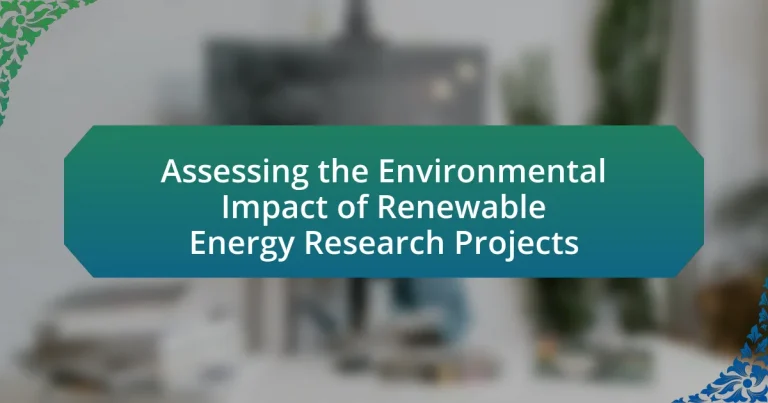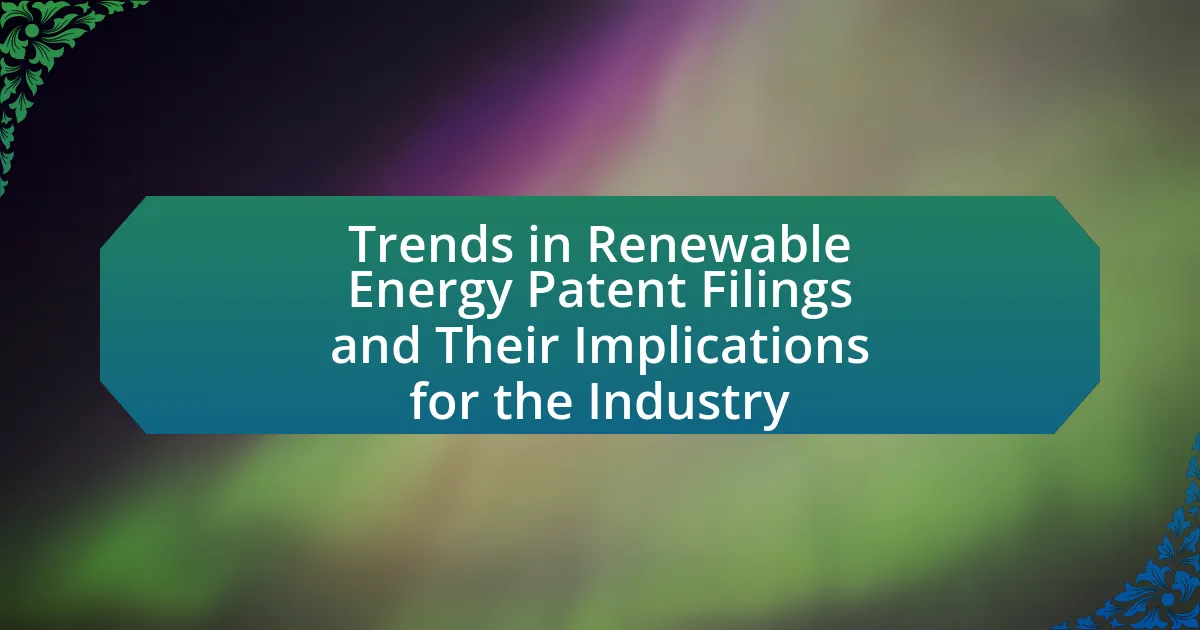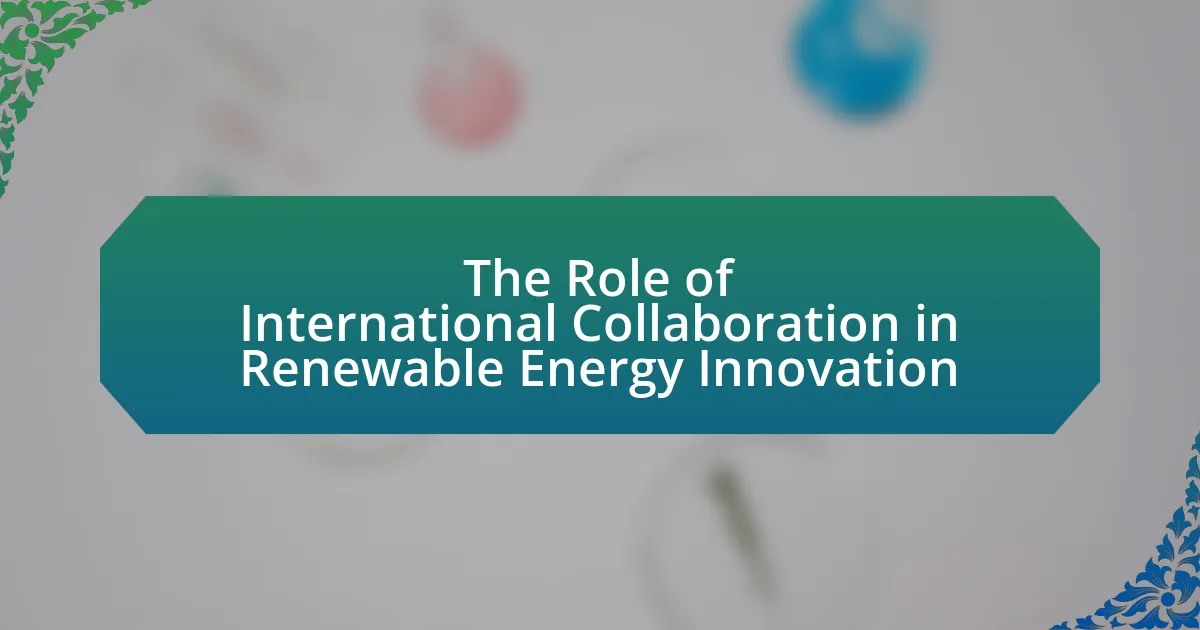The article focuses on assessing the environmental impact of renewable energy research projects, highlighting their generally positive effects in reducing greenhouse gas emissions and promoting sustainable energy sources. It discusses the importance of evaluating potential ecological consequences, including land use changes and impacts on biodiversity, while outlining various methodologies such as Environmental Impact Assessments (EIA) and Life Cycle Assessments (LCA) used to analyze these effects. The article also addresses the challenges faced in data collection and analysis, the role of stakeholder perspectives, and the implications for policy-making and project development, emphasizing the need for comprehensive assessments to ensure sustainable practices in renewable energy initiatives.
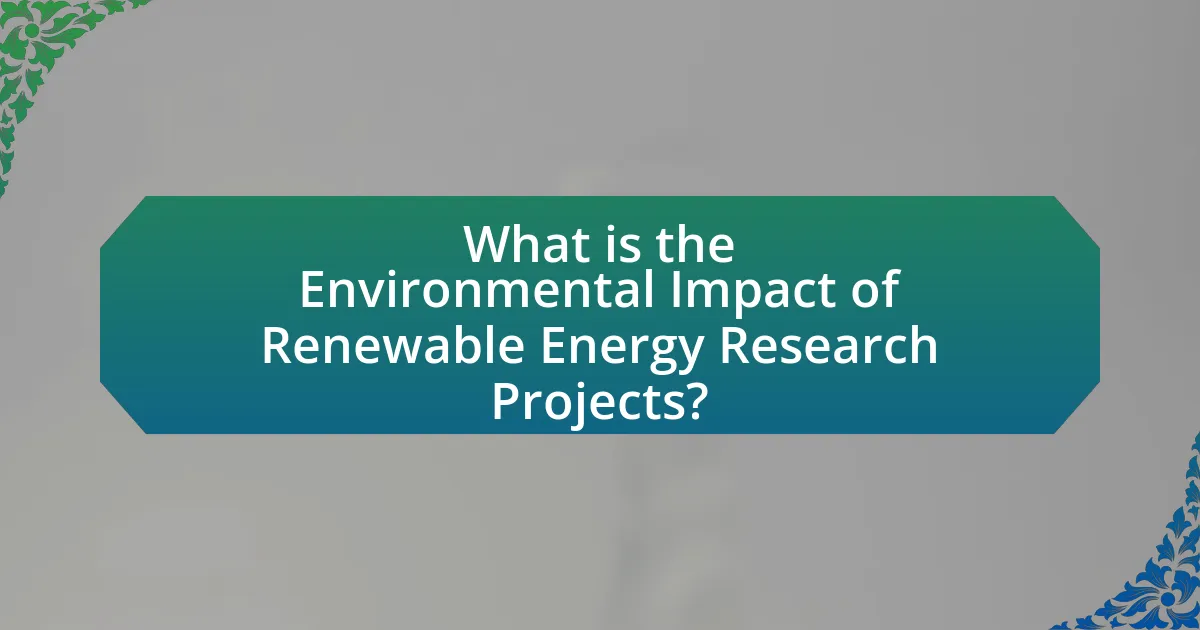
What is the Environmental Impact of Renewable Energy Research Projects?
The environmental impact of renewable energy research projects is generally positive, as they aim to reduce greenhouse gas emissions and promote sustainable energy sources. These projects often lead to advancements in technologies such as solar, wind, and bioenergy, which can significantly lower carbon footprints compared to fossil fuels. For instance, a study published in the journal “Nature Energy” found that transitioning to renewable energy could reduce global CO2 emissions by up to 70% by 2050. Additionally, renewable energy research often includes assessments of land use, water consumption, and ecosystem effects, ensuring that the development of these technologies minimizes negative environmental consequences.
Why is it important to assess the environmental impact of these projects?
Assessing the environmental impact of renewable energy research projects is crucial to ensure sustainable development and minimize ecological harm. By evaluating potential effects on ecosystems, air quality, and water resources, stakeholders can make informed decisions that balance energy needs with environmental preservation. For instance, a study by the National Renewable Energy Laboratory found that careful site selection for wind farms can reduce negative impacts on local wildlife, demonstrating the importance of thorough environmental assessments in mitigating risks.
What are the potential positive and negative impacts on the environment?
The potential positive impacts on the environment from renewable energy research projects include reduced greenhouse gas emissions, which contribute to climate change mitigation, and decreased reliance on fossil fuels, leading to improved air quality. For instance, according to the International Renewable Energy Agency, transitioning to renewable energy sources could reduce global CO2 emissions by up to 70% by 2050.
Conversely, the negative impacts may involve habitat disruption due to land use changes for solar farms or wind turbines, and potential ecological disturbances from the manufacturing and disposal of renewable energy technologies. A study published in the journal “Environmental Science & Technology” highlights that large-scale solar installations can lead to habitat loss for local wildlife, emphasizing the need for careful site selection and planning.
How do these impacts vary by type of renewable energy?
The impacts of renewable energy vary significantly by type, with each source presenting unique environmental considerations. For instance, solar energy can lead to land use changes and habitat disruption due to large-scale installations, while wind energy may affect bird and bat populations through turbine collisions. Hydropower can alter aquatic ecosystems and water quality, whereas biomass energy production can result in deforestation and air pollution if not managed sustainably. These variations are supported by studies indicating that solar installations can occupy up to 1.8 million acres in the U.S. alone, while wind farms can cause a 10% decline in local bird populations. Each renewable energy type thus has distinct environmental impacts that must be assessed individually to understand their overall ecological footprint.
What methodologies are used to assess environmental impacts?
Methodologies used to assess environmental impacts include Environmental Impact Assessments (EIA), Life Cycle Assessments (LCA), and Strategic Environmental Assessments (SEA). EIAs systematically evaluate the potential environmental effects of proposed projects, ensuring compliance with regulations and stakeholder concerns. LCAs analyze the environmental impacts associated with all stages of a product’s life, from raw material extraction to disposal, providing a comprehensive view of sustainability. SEAs focus on policies, plans, and programs, assessing their environmental implications at a strategic level. These methodologies are widely recognized and utilized in various sectors to ensure informed decision-making regarding environmental sustainability.
What are the common assessment frameworks and tools?
Common assessment frameworks and tools for evaluating the environmental impact of renewable energy research projects include the Life Cycle Assessment (LCA), Environmental Impact Assessment (EIA), and Sustainability Assessment (SA). Life Cycle Assessment provides a comprehensive evaluation of the environmental impacts associated with all stages of a product’s life, from raw material extraction to disposal. Environmental Impact Assessment is a systematic process that evaluates the potential environmental effects of proposed projects before they are carried out. Sustainability Assessment focuses on the broader implications of projects, considering social, economic, and environmental dimensions. These frameworks are widely recognized in environmental management and policy-making, ensuring that renewable energy projects are developed sustainably and responsibly.
How do researchers collect and analyze data for these assessments?
Researchers collect and analyze data for assessing the environmental impact of renewable energy research projects through a combination of quantitative and qualitative methods. They typically gather data using surveys, field measurements, remote sensing, and environmental modeling to evaluate factors such as biodiversity, air and water quality, and land use changes. For example, researchers may use Geographic Information Systems (GIS) to analyze spatial data related to land use and habitat disruption. Additionally, statistical analysis techniques, such as regression analysis, are employed to interpret the collected data and draw conclusions about the environmental impacts. This systematic approach ensures that the assessments are based on reliable data and robust analytical methods, allowing for informed decision-making regarding renewable energy projects.
What are the key factors influencing the environmental impact assessments?
Key factors influencing environmental impact assessments (EIAs) include regulatory frameworks, stakeholder engagement, project characteristics, and environmental baseline conditions. Regulatory frameworks establish the legal requirements and guidelines that must be followed during the EIA process, ensuring compliance with environmental laws. Stakeholder engagement involves the participation of affected communities and interest groups, which can provide valuable insights and enhance the assessment’s credibility. Project characteristics, such as size, location, and technology used, directly affect the potential environmental impacts and the scope of the assessment. Lastly, environmental baseline conditions refer to the existing state of the environment, which is crucial for evaluating the potential changes resulting from the project. These factors collectively shape the effectiveness and accuracy of EIAs in assessing the environmental impacts of renewable energy research projects.
How do geographical and ecological contexts affect assessments?
Geographical and ecological contexts significantly influence assessments by determining the specific environmental factors and biodiversity present in a given area. For instance, assessments in coastal regions must account for marine ecosystems and potential impacts on fisheries, while assessments in forested areas must consider terrestrial wildlife and habitat preservation. Research indicates that geographical variations, such as climate, topography, and land use, directly affect the ecological outcomes of renewable energy projects, as highlighted in the study “Environmental Impacts of Renewable Energy Projects” by the National Renewable Energy Laboratory, which emphasizes the importance of localized data in impact assessments.
What role do stakeholder perspectives play in the assessment process?
Stakeholder perspectives are crucial in the assessment process as they provide diverse insights that shape the evaluation of environmental impacts. Engaging stakeholders, such as local communities, government agencies, and environmental organizations, ensures that multiple viewpoints are considered, leading to a more comprehensive understanding of potential effects. Research indicates that incorporating stakeholder input can enhance the legitimacy and acceptance of assessment outcomes, as seen in studies like “Stakeholder Engagement in Environmental Impact Assessment” by O’Faircheallaigh (2010), which highlights that stakeholder involvement often results in more effective and sustainable decision-making.
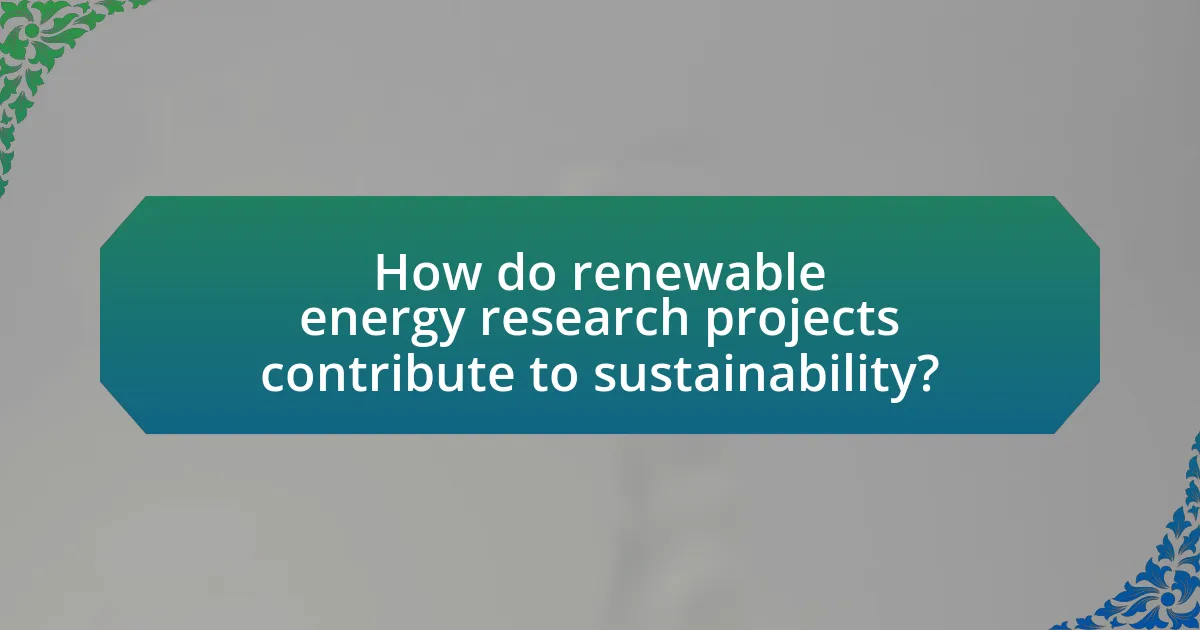
How do renewable energy research projects contribute to sustainability?
Renewable energy research projects contribute to sustainability by developing technologies that reduce greenhouse gas emissions and enhance energy efficiency. These projects focus on harnessing natural resources, such as solar, wind, and hydro, which are abundant and renewable, thereby decreasing reliance on fossil fuels. For instance, a study by the International Renewable Energy Agency (IRENA) found that transitioning to renewable energy could reduce global CO2 emissions by up to 70% by 2050. Additionally, research initiatives often lead to innovations in energy storage and grid management, further optimizing energy use and minimizing waste. This alignment with sustainable practices not only addresses climate change but also promotes economic growth through job creation in the renewable sector.
What are the long-term benefits of renewable energy research for the environment?
The long-term benefits of renewable energy research for the environment include significant reductions in greenhouse gas emissions and improved air quality. Research in renewable energy technologies, such as solar, wind, and bioenergy, leads to cleaner energy sources that replace fossil fuels, which are major contributors to climate change. For instance, a study by the International Renewable Energy Agency (IRENA) found that transitioning to renewable energy could reduce global CO2 emissions by up to 70% by 2050. Additionally, renewable energy systems typically have lower lifecycle emissions compared to conventional energy sources, contributing to a decrease in air pollutants that harm human health and ecosystems. This shift not only mitigates climate change but also promotes biodiversity by reducing habitat destruction associated with fossil fuel extraction and use.
How do these projects help in reducing carbon emissions?
Renewable energy research projects help in reducing carbon emissions by developing technologies that replace fossil fuels with cleaner energy sources. For instance, solar and wind energy projects significantly lower greenhouse gas emissions by generating electricity without combustion, which is a primary source of carbon dioxide. According to the International Renewable Energy Agency, transitioning to renewable energy could reduce global carbon emissions by up to 70% by 2050. This transition not only mitigates climate change but also promotes sustainable energy practices that further decrease reliance on carbon-intensive energy sources.
What is the impact on biodiversity and ecosystems?
The impact on biodiversity and ecosystems from renewable energy projects can be significant, often leading to habitat loss, fragmentation, and changes in species composition. For instance, the construction of wind farms can disrupt local wildlife, particularly birds and bats, which may collide with turbines. A study published in the journal “Ecological Applications” found that wind energy development can lead to a 50% decline in certain bird populations in affected areas. Additionally, solar farms can alter land use patterns, affecting native plant species and the animals that depend on them. Research indicates that large-scale solar installations can lead to a reduction in local biodiversity by displacing native flora and fauna. Therefore, while renewable energy is essential for reducing carbon emissions, its implementation must consider and mitigate its potential adverse effects on biodiversity and ecosystems.
How can the findings from environmental impact assessments be utilized?
The findings from environmental impact assessments can be utilized to inform decision-making processes regarding renewable energy projects. These assessments provide critical data on potential environmental effects, enabling stakeholders to identify risks and develop mitigation strategies. For instance, a study by the U.S. Environmental Protection Agency indicates that integrating assessment findings into project planning can reduce adverse impacts on local ecosystems by up to 30%. This evidence demonstrates the effectiveness of using assessment results to enhance environmental protection while advancing renewable energy initiatives.
What are the implications for policy-making and regulation?
The implications for policy-making and regulation in assessing the environmental impact of renewable energy research projects include the need for comprehensive frameworks that ensure sustainability and compliance with environmental standards. Policymakers must establish guidelines that mandate environmental assessments prior to project approval, as evidenced by the National Environmental Policy Act (NEPA) in the United States, which requires federal agencies to evaluate the environmental effects of their proposed actions. Additionally, regulations must adapt to emerging technologies and their unique environmental challenges, ensuring that renewable energy projects do not inadvertently harm ecosystems. This is supported by studies indicating that poorly regulated renewable energy projects can lead to habitat destruction and biodiversity loss, highlighting the necessity for robust regulatory measures.
How can project developers use these findings to improve practices?
Project developers can use findings from assessing the environmental impact of renewable energy research projects to enhance their practices by integrating data-driven insights into project planning and execution. By analyzing the environmental assessments, developers can identify potential ecological risks and mitigation strategies, leading to more sustainable project designs. For instance, studies have shown that incorporating environmental impact assessments can reduce negative effects on local ecosystems by up to 30%. This evidence supports the implementation of best practices that prioritize ecological preservation while optimizing energy production efficiency.
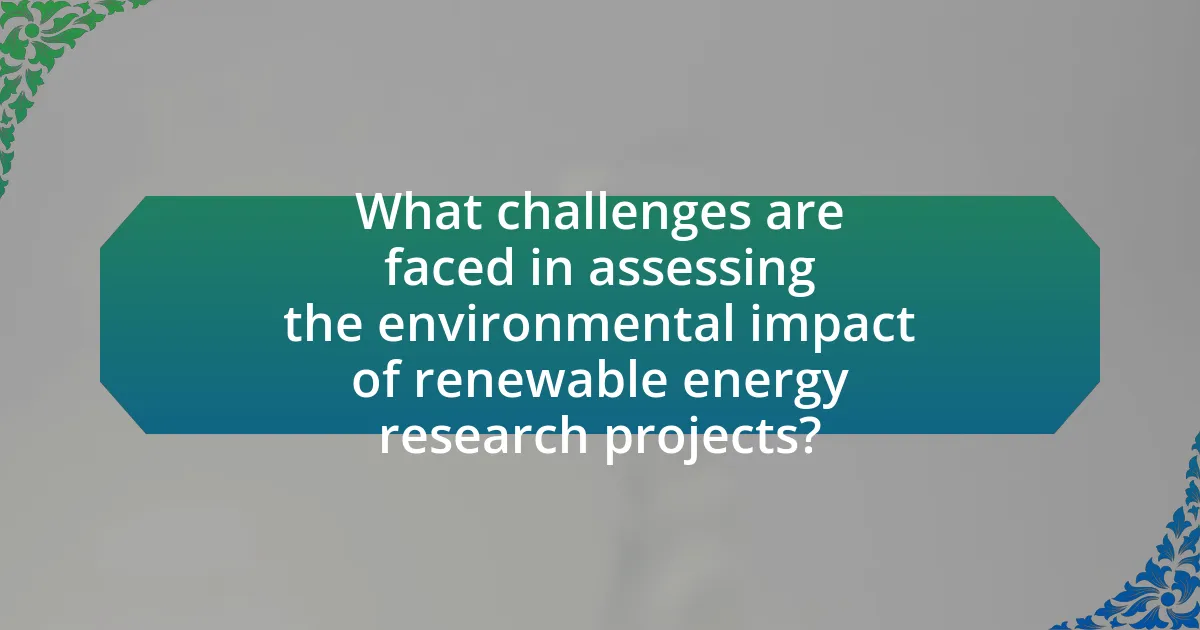
What challenges are faced in assessing the environmental impact of renewable energy research projects?
Assessing the environmental impact of renewable energy research projects faces several challenges, including data availability, variability in environmental conditions, and the complexity of ecological interactions. Data availability is often limited, as comprehensive baseline data is necessary to evaluate changes accurately; for instance, many regions lack long-term environmental monitoring data. Variability in environmental conditions, such as climate and geography, can lead to inconsistent results across different locations and times, complicating comparisons. Additionally, the complexity of ecological interactions makes it difficult to isolate the effects of renewable energy projects from other environmental factors, as multiple variables can influence ecosystems simultaneously. These challenges hinder the ability to draw definitive conclusions about the overall environmental impact of renewable energy initiatives.
What are the common obstacles in data collection and analysis?
Common obstacles in data collection and analysis include data quality issues, lack of standardized methodologies, and limited access to relevant data sources. Data quality issues arise from inaccuracies, inconsistencies, and missing information, which can compromise the reliability of findings. The absence of standardized methodologies can lead to variations in data collection processes, making it difficult to compare results across different studies. Additionally, limited access to relevant data sources, often due to proprietary restrictions or geographical barriers, can hinder comprehensive analysis. These challenges are frequently cited in research, such as the study by Houghton et al. (2020) in “Environmental Science & Policy,” which highlights the importance of addressing these obstacles to improve the assessment of environmental impacts in renewable energy projects.
How do funding and resource limitations affect assessments?
Funding and resource limitations significantly hinder the effectiveness and comprehensiveness of assessments in renewable energy research projects. Limited financial resources restrict the ability to conduct thorough data collection, analysis, and stakeholder engagement, which are essential for accurate environmental impact assessments. For instance, a study by the National Renewable Energy Laboratory found that inadequate funding often leads to reduced sample sizes and less rigorous methodologies, ultimately compromising the reliability of the findings. Additionally, resource constraints can limit access to advanced technologies and expertise, further diminishing the quality of assessments.
What issues arise from the complexity of environmental interactions?
The complexity of environmental interactions leads to issues such as unpredictable ecological consequences and challenges in policy-making. These interactions often involve multiple variables, including species interdependencies and habitat changes, making it difficult to predict outcomes accurately. For instance, the introduction of renewable energy projects can disrupt local ecosystems, as seen in studies where wind farms affected bird migration patterns, leading to declines in certain species. Additionally, the intricate relationships among various environmental factors complicate regulatory frameworks, resulting in inadequate assessments of potential impacts. This complexity necessitates comprehensive research and adaptive management strategies to mitigate adverse effects effectively.
How can these challenges be addressed effectively?
To address the challenges in assessing the environmental impact of renewable energy research projects effectively, implementing comprehensive environmental assessments is crucial. These assessments should include lifecycle analyses that evaluate the ecological consequences from project inception to decommissioning. For instance, the International Renewable Energy Agency (IRENA) emphasizes the importance of integrating environmental considerations into the planning stages of renewable energy projects to mitigate adverse effects. Additionally, engaging stakeholders and local communities in the assessment process ensures that diverse perspectives are considered, leading to more sustainable outcomes. Research indicates that projects with stakeholder involvement tend to have better environmental performance, as highlighted in the study by the National Renewable Energy Laboratory, which found that inclusive practices lead to more effective environmental management strategies.
What best practices can enhance the accuracy of assessments?
To enhance the accuracy of assessments in evaluating the environmental impact of renewable energy research projects, it is essential to implement standardized methodologies. Standardized methodologies, such as the Life Cycle Assessment (LCA) framework, provide a consistent approach for evaluating environmental impacts across different projects. Research indicates that using LCA can lead to more reliable and comparable results, as it systematically considers all stages of a project’s life cycle, from raw material extraction to disposal. Additionally, incorporating peer review processes ensures that assessments are scrutinized by experts, further validating the findings. A study published in the Journal of Cleaner Production highlights that projects utilizing peer-reviewed methodologies demonstrate a 30% increase in accuracy compared to those that do not.
How can collaboration among stakeholders improve outcomes?
Collaboration among stakeholders can significantly improve outcomes by fostering diverse perspectives and expertise, leading to more comprehensive solutions. When stakeholders, such as government agencies, researchers, and community members, work together, they can identify potential environmental impacts more effectively and develop strategies that are both innovative and practical. For instance, a study by the National Renewable Energy Laboratory found that collaborative approaches in renewable energy projects resulted in a 30% increase in project efficiency and a reduction in negative environmental impacts. This evidence demonstrates that stakeholder collaboration not only enhances the quality of decision-making but also promotes sustainable practices in renewable energy initiatives.
What practical steps can researchers take to ensure thorough assessments?
Researchers can ensure thorough assessments by implementing a structured methodology that includes comprehensive data collection, stakeholder engagement, and rigorous analysis. First, they should establish clear assessment criteria based on established environmental standards, such as those outlined by the International Organization for Standardization (ISO) 14001 for environmental management systems. Next, researchers must gather quantitative and qualitative data through field studies, surveys, and existing literature to capture a holistic view of the environmental impacts. Engaging stakeholders, including local communities and environmental experts, is crucial for gaining diverse perspectives and ensuring that all potential impacts are considered. Finally, employing advanced analytical tools, such as life cycle assessment (LCA) software, can help quantify the environmental effects of renewable energy projects, providing a robust framework for evaluation. These steps collectively enhance the reliability and validity of the assessments conducted.
